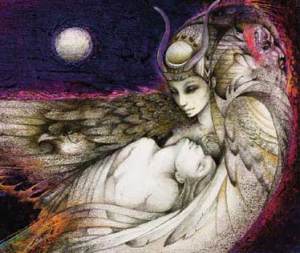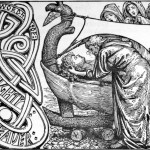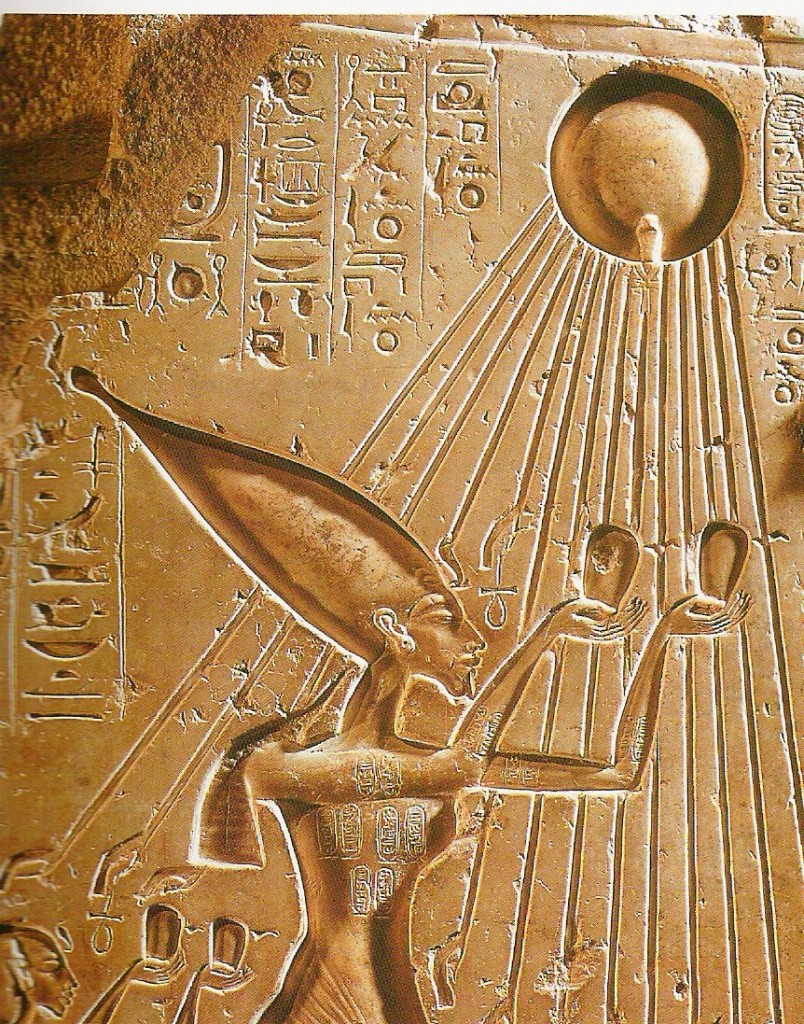
Introduction
The last family ritual we did was at Midsummer. What is Midsummer? It’s also called First Fruits. Do you remember what we did? Why did we do that?
Today is the Fall Equinox. What is the Equinox?
Today is about sacrifice. And it is about the connection between death and life. Today is also called “Harvest Home” by some Pagans. Why do you think that is? What is the most common grain around here? We’re going to be learning about an Egyptian myth today. Do you know what the most common grain was in ancient Egypt? And with barley the Egyptians made their two most important foods. Do you know what they were?
In Pagan myth, the symbol of the god is split between two persons: the god of light, and his twin, the god of darkness. They are represented by the Oak King and the Holly King in Neopagan myth. There are other examples as well. Often these characters are depicted as fighting battles every spring and fall for the favor of the goddess, who represents Nature.
The god of light is born at the winter solstice, the longest night, and his strength grows with the lengthening days, until the moment of his greatest power, the summer solstice, the longest day. And then his “shadow”, the god of darkness, is born at the summer solstice, the longest day. Then the strength of the god of light weakens with the lengthening nights until the moment of his rebirth, the winter solstice.
Today is the autumn equinox, a day of balance between the light and dark, just between the summer and winter solstices. This the tipping point just before the dark begins its triumph. Now we’re going to listen to a song about the battle between the god of light, the Oak King, and the god of darkness, the Holly King.
“Noon of the Solstice”
by Damh the Bard
In times long past
lived a Man of green,
And his footsteps brought life wherever he’d been.
In the deepest wildwood
was the place he was seen,
And the people did love
and protect him.
And they saw his face change,
with the turn of the Wheel
of the Seasons,
They heard his voice sing.
(Chorus)
I’m the Horned God,
I’m the face in the trees,
I’m the breath of the wind that rustles the leaves,
I’m the Green Man
in the wildwood I roam,
Cernunnos, I’m Pan and I’m Herne.
I shall be as the Dark Holly King,
Darkness and cold
in my cloak I will bring,
And on Winter’s nights
to me you will sing,
Till the air around me starts changing,
And on the noon of the solstice
I’ll give up my crown,
To the Light
and the Mighty Oak King.
All Summer long
I shall rule just and fair,
Bring your crops to fruit
with the light that I share,
With fire and water,
from earth into air,
But the Wheel it keeps
steadily turning.
And on the noon of the Solstice
I’ll give up my crown,
To the cold and the Dark Holly King.
T’is now modern times
and the Summer is here,
The Winter has gone
and the air it is clear,
On a fine day I walked
through a woods I live near,
When a battle I spied
through a clearing,
Two giants of leaves,
one light and one dark,
Even now the Wheel it is turning!
One of the most important stories in Pagan myth is the story of the Dying God or the Dying Goddess. Can you think of any examples of dying gods or dying goddesses? There are many stories like this: The Greek god of wine, Dionysus. The Canaanite god Ba’al and the Babylonian god Tammuz, who are mentioned in the Bible. The Viking god Balder. And the Egyptian god Osiris. Today we are going to learn the story of Osiris and his wife, Isis.
The story of Osiris and Isis is one of many such stories that Pagans today understand in the same way. The Goddess in the story is immortal. She never dies. She always was and She and always will be. She is Womb from which the Universe is born. Her Lover, the god, is the principle of mortality. He represents everything that is born, dies, and is reborn in an ever-repeating cycle of birth, death and rebirth.
The Goddess is Ground of Being; the god is That-Which-Is-Brought-Forth. The Goddess is the earth; the god is the grain. She is the all encompassing Sky; he is the Sun which moves across the sky, born from the earth in the east in the morning, moving across the sky during the day, dying in the earth in the west in the evening, and traveling under the earth in darkness during the night. The Goddess is the Wheel; the god is the traveler on the Wheel. She is Life, of which Death is a part; he is the sacrifice of Life to Death so that Life may go on. She is the Mother and the Destroyer, the beginning and the end, the Womb and the Tomb; he is all that is born and is destroyed.
In rituals like the one we will do today, we identify with the sacrificed God. In doing so, we honor the circle of life. Waxing and waning, birth and death, growth and decline: all take place in nature, in the human life cycle, and in the human soul. Each stage is to be welcomed in its proper time and season, because life is a process of constant change. When we identify with the god, we choose to surrender to the Cycle, to ride the Wheel that is the Goddess.
Ritual Drama
[My daughter dresses as the goddess, Isis; my son dresses as Set. We go outside to the erect corn stalk.]
This is the story of Isis and Osiris. Long ago, at the beginning of the world, Nut, the sky goddes, and Geb, the god of the earth, gave birth to four children: Osiris, Isis, Set, and Nepthys. Geb, the earth, gave Osiris the dark, rich soil and the waving corn. Nut, the sky, gave Isis moisture, the rain and dew. Isis and Osiris loved each other from the beginning of time and they were married. Osiris became the first king of Egypt, and Isis the first Queen. They taught their people to plant grain and to harvest it, to make bread and beer, so that the people were no longer hungry. They taught them to honor the gods, and gave them laws to teach them justice.
[We play “Rise of the Corn” while Isis dances around the corn stalk.]
Rise of the Corn
by Carolyn Hillyer
I sing the ripening corn to you
I sing this pathway to you
that you may come where two hills meet
and I wait at water’s edge.
I hear your heartbeat through the earth
sitting in my joy of you
sitting in my joy of you
wind brings your whisper.
I watch the horizon
and feel my blood’s deep pulse
I sing the ripening corn to you
that you may come.
I hear your heartbeat through the earth
sitting in my joy of you
I sing the ripening corn to you
that you may come.
I sing the ripening corn to you
that you may come [repeat 4 times]
Now Set was a different sort of god. He had red hair, unlike all the other gods, whose hair was black. Set lived in the desert, where the Sun scorched the ground so nothing would grow. He was a god of harsh desert winds that blew hot sands across the green fields.
Set saw how the people of Egypt loved his brother, Osiris, and he was jealous. Set wanted to rule as king in his brother’s place, but he kept his desire secret. One day, Osiris decided to go on a journey to see all of the land he ruled. He left Isis to rule Egypt alone while he was gone. One night, Osiris was hunting a wild boar in the swampy land of the delta of the Nile river, when Set came across Osiris alone. He cut down Osiris with his sword. Then he tore Osiris’s body apart, dividing it into seven pieces and scattered them across the land.
[Set cuts the stalk down. The he reaps an ear of grain and scatters the kernels far and wide to make them hard to find.]
When Isis heard the news that Osiris was dead, she wept so much that her tears flooded the Nile river. She cut her hair short and covered her head with a veil of mourning.
[Isis places veil of morning on her head, and assumes an attitude of mourning.]
This is an ancient Babylonian poem from the 7th century BC. It is a lamentation for the Dying God, Tammuz:
Her lament is for the field, where the corn grows no more.
Her lament is for the woods, where the tamarisks grow no more.
Her lament is for the garden, where honey and wine grow no more.
Her lament is for the great river, where brings the flood no more.
Her lament is for the flocks, which bring forth no more.
Her lament is for the habitations, where the wedded ones create no more.
The goddess cries out like a woman in travail:
[Isis reads:]
My lord lives no more.
My son lives no more.
The husband of the queen lives no more.
The fruit of the land lives no more.
The god of the grain has been destroyed.
He was seized away.
In the fields they have slain him.
By the windy storm he was brought low.
Like a reed he is fallen.
Like the tree which has no water is he.
Like the plant that sends forth no shoots,
Whose roots are torn away.
To the heart of the earth he has gone.
To the pit he has taken his way.
In the buried grain he lies.
Now in darkness the shepherd sits.
How long shall the springing of life be held back?
How long shall the putting forth of leaves be held back?
Who shall bring the overflow of waters?
Who will restore?
[Isis reenacts the following scene, gathering seven kernels.]
Isis set out to find the body of her husband. For a long time, Isis wandered the land searching. Eventually, she found one of the pieces of Osiris’s body. She kept looking until she had found all seven parts of his body.
Then she put all the pieces back together. [Isis places the kernels in the basket, and then covers the basket with a black cloth.] But Osiris was still dead. So Isis turned herself into a bird with her magic. She flapped her wings and the wind blew into the nostrils of Osiris. Osiris was revived. But it was not to last. So Isis lay with her husband one last time, and she conceived a son, Horus, who would become the avenger of his father, and would one day overthrow Set, with the help of his mother Isis.
Ritual
Now each of us is going to gather seven grains, one for each part of Osiris’s body. When we have gathered them together, we will gather round the basket again.
Before we start gathering, you will repeat some words after me. When you are gathering, you will repeat the last line to yourself each time you gather a grain:
Thou art I, and I am thou.
Wherever I may be, there you are.
In all you are scattered.
And whenever I will, I gather you.
And gathering you, I gather myself.
Repeat the last line as you gather each grain: “And gathering you, I gather myself.”
[When everyone has gathered their grains …]
Now gather round the basket while holding your grains in both hands.
We will now sing the chant “Osiris Lives”. We will listen to it once and then sing it three times.
“Osiris Lives”
by Sharon Knight and Thorn Coyle
Red barley and grape on the vine
Green waters of the rising Nile (sing 2 times)
Osiris lives, Osiris returns, what is true will never die. (sing 2 times)
(What is true will live forever, what is true will always be.)
(Osiris lives, the God returns, Osiris lives, the God in me.)
Now we will line up and each of us will place our grains in the basket one at a time. When you place your grains in the basket, you will say:
Crops rushing forth from the deep
Then Isis will say:
A babe rushing forth from the womb
Then you will take something from the basket.
[Isis covers the grains and uncovers the bread.]
Gather round the basket again.
The following poem is a spell which was written on the inside of Egyptian coffins. Egyptians would paint in the inside of the coffin to make it look like a field of grain. And they would include spells like this one for the dead person to read. Everyone repeat after me:
Whether I live or die, I am Osiris.
I come forth out of thee. I enter into thee.
I grow in thee. I decay in thee.
I rise up. I am cut down.
I live and grow in the corn.
The corn feeds mortals. The corn feeds the gods.
I cover the earth. The earth hides me.
Whether I live or die, I am the corn.
I will not perish,
For I am become one with the Order.
I have entered into the Order.
I will emerge in the Order.
We will now eat the bread in silence.
[When everyone has eaten the bread …]
Now we will give thanks by singing the chant “Bounty of the Harvest”. We will listen to it once and sing it three times.
“Bounty of the Harvest”
by Thorn Coyle and Sharon Knight
Let’s give thanks for the bounty of the harvest
The Barley King has bowed his head
Let’s give thanks for the beauty all around us
Pour the wine and break the bread!
Oh – Pass the horn of plenty
Oh – Thanks be for nature’s bounty
After she conceived Horus, Isis took the body of Osiris and buried him in the earth. When Osiris was buried, he went to rule as king in the Underworld. Every night, when the Sun journeys to the Underworld, Osiris is there to guide him back to the Gates of Morning. And when people die and go to the Underworld, Osiris rules over them. As a god of the Underworld, Osiris also is the source of the fertility of the land. He makes the grain grow.
[Isis cuts her black veil and wraps the ear of corn in it. She then deposits the effigy in the pre-dug grave.]
[Isis marks everyone’s forehead with ashes from the Summer solstice fire.]
The following words are from the Bible, but have been changed for our purposes today. Repeat after me.
They that reap in tears shall sow in joy.
They that go forth weeping
bearing sheaves of grain with them,
shall doubtless come again with rejoicing,
bearing precious seed.
Conclusion
Thank you everyone for participating.
Now we’re going to have a ritual critique. Everyone will say one thing they liked and one thing they would like to improve about the ritual.















